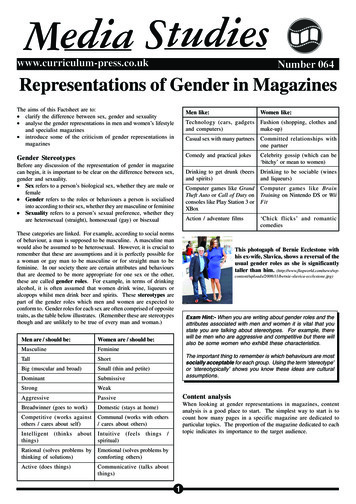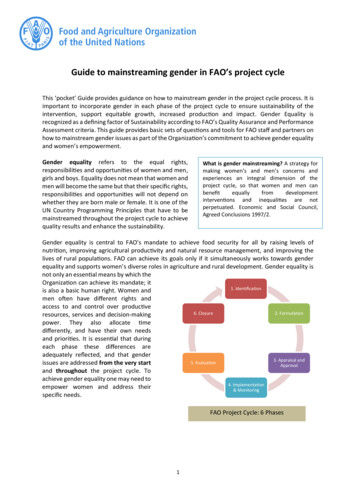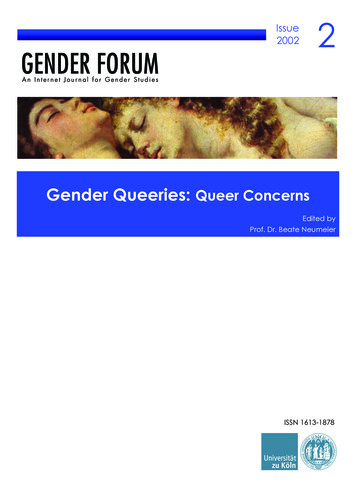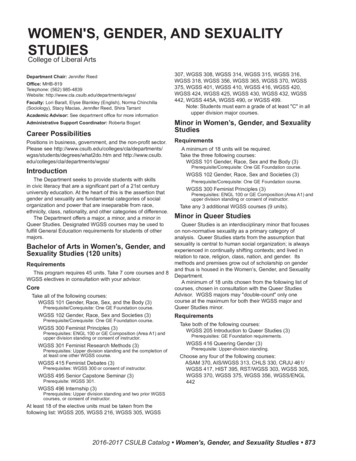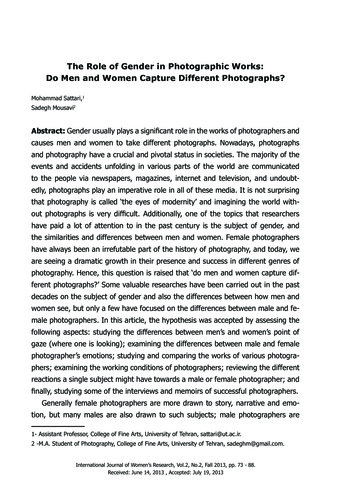
Transcription
The Role of Gender in Photographic Works:Do Men and Women Capture Different Photographs?Mohammad Sattari,1Sadegh Mousavi2Abstract: Gender usually plays a significant role in the works of photographers andcauses men and women to take different photographs. Nowadays, photographsand photography have a crucial and pivotal status in societies. The majority of theevents and accidents unfolding in various parts of the world are communicatedto the people via newspapers, magazines, internet and television, and undoubtedly, photographs play an imperative role in all of these media. It is not surprisingthat photography is called ‘the eyes of modernity’ and imagining the world without photographs is very difficult. Additionally, one of the topics that researchershave paid a lot of attention to in the past century is the subject of gender, andthe similarities and differences between men and women. Female photographershave always been an irrefutable part of the history of photography, and today, weare seeing a dramatic growth in their presence and success in different genres ofphotography. Hence, this question is raised that ‘do men and women capture different photographs?’ Some valuable researches have been carried out in the pastdecades on the subject of gender and also the differences between how men andwomen see, but only a few have focused on the differences between male and female photographers. In this article, the hypothesis was accepted by assessing thefollowing aspects: studying the differences between men’s and women’s point ofgaze (where one is looking); examining the differences between male and femalephotographer’s emotions; studying and comparing the works of various photographers; examining the working conditions of photographers; reviewing the differentreactions a single subject might have towards a male or female photographer; andfinally, studying some of the interviews and memoirs of successful photographers.Generally female photographers are more drawn to story, narrative and emotion, but many males are also drawn to such subjects; male photographers are1- Assistant Professor, College of Fine Arts, University of Tehran, sattari@ut.ac.ir.2 -M.A. Student of Photography, College of Fine Arts, University of Tehran, sadeghm@gmail.com.International Journal of Women’s Research, Vol.2, No.2, Fall 2013, pp. 73 - 88.Received: June 14, 2013 , Accepted: July 19, 2013
International Journal of Women’s ResearchVol. 2, No. 2, Fall 2013more drawn to technical and action-filled subjects, but many females are alsodrawn to such subjects. Hence, for each stereotype regarding photographs andgender, numerous photographers or photographs can be found that challenge ordefy it. Men and women capture different photographs but this should not give usthe excuse to impose our stereotypes and clichés on a particular photographer,whether male or female.Keywords: Photo, Men, Women, Gender, Eye TrackingIntroductionNowadays, photographs and photography have a crucial and pivotal status. Themajority of the events and accidents unfolding in various parts of the world arecommunicated to the people via newspapers, magazines, internet and television,and undoubtedly, photographs play an imperative role in all of these media. Forexample, a major part of an Iranian teenager’s perception and idea of the VietnamWar is formed by the pictures that he or she has seen from that event. Furthermore, since in the minds of ordinary people, a photograph is considered very convincing and seemingly trustworthy, and is also incorrectly treated as innocent andunbiased, its effectiveness and advantage is multiplied. In the words of David Bate(2009, 17) “photographs give the illusion of a transparent access to ‘reality’ as thereal ‘language’ of photography”. It is not surprising that photography is called ‘theeyes of modernity’ and imagining the world without photographs is very difficult. Inthe past two decades and after the spread of digital photography and mobile phonecameras, the general public has more than ever photographed everyday events,street life, trips, and tragic accidents, and some of them are newsworthy images.On the one hand, one of the topics that researchers - psychologists, sociologistsand physicians in particular - have paid a lot of attention to in the past centuryis the subject of gender, women’s rights, and also the similarities and differencesbetween men and women. In Iran, some fruitful researches and also initiativeshave been carried out, especially after the Islamic Revolution in 1979. On the otherhand, women photographers have always been an irrefutable part of the history ofphotography, and in recent years, we are witnessing a steady rise in their presenceand success in different genres of photography, such as photojournalism, fine art,74
The Role of Gender in Photographic Works:architecture, portrait, commercial, industrial, and even war photography. In thefield of art and photography education around the world, the number of femalestudents is also constantly growing; for example, at prestigious universities suchas The Rochester Institute of Technology and The Art Center College of Design inPasadena, women now outnumber men (Mitchell, 2009). Hence, this question israised that ‘do men and women capture different photographs?’This article’s hypothesis is as follows: Gender usually plays a significant role in theworks of photographers and causes men and women to take different photographs.The research subject of gender is an important, endless and multidimensionalsubject, and when the difference between men and women is examined, the research becomes even more interesting; especially when this comparison is performed in an ever-growing field such as photography. Some valuable researcheshave been carried out in the past few decades on the subject of gender and alsothe differences between men and women’s point of gaze (where one is looking),but only a few have focused on the differences between male and female photographers. In this article, first a review of literature will be presented; subsequently,in the research statement’s section, a description of how the research is carriedout will be presented and some of the differences between male and female photographers, such as their point of gaze (where one is looking) and their workingconditions will be discussed. In the discussion section, a handful of examples thatchallenge the hypothesis will be analyzed; finally, the article’s hypothesis is testedagainst the findings of the research and the conclusions are stated.Literature ReviewA myriad of researches have been carried out in the field of gender and a limitednumber of those studies focused on the differences between the sexes, but only afew have concentrated on the role of gender in the works of photographers.Vassalo et al. (2009) study the difference between how men and women orienttheir visual attention to the image of various portraitures containing a particularstatic emotional facial expression, using a technology by the name of eye tracking(the method which human’s eyes look at a scene / image by recording and analyzing the eye movements). In this study, 50 healthy participants (23 male and 27female) view a series of six universal facial expressions, while the participants’ eye75
International Journal of Women’s ResearchVol. 2, No. 2, Fall 2013movements are recorded. Subsequently, their accuracy and reaction time in correctly identifying the expressions are measured. This study concludes that in identifying the expressions correctly, there is no difference between men and women;however, women recognize this expression significantly faster than men. Furthermore, for the first time this study proves that even though both sexes look morefrequently and spend most of their time at the subjects’ eye region, men spendmore time looking at the subjects’ mouth and nose.Anderson et al.(2012) examines sex differences in virtual navigation using eyetracking and concludes that men and women see in dissimilar ways and focus ondifferent parts during navigation.Among the relevant literatures that have been reviewed by the author, Mitchell(2009) concentrates more on the differences between male and female photographers. This research relies on studying the works of male and female photographers, interviewing critics and well-known photographers, as well referring toa couple of eye tracking studies. Mitchell concludes that most men, compared towomen, capture different photographs. One of the shortcomings of the aforementioned research is that it does not sufficiently address the working environment ofphotographers and how it affects men and women in various cultures.Research StatementThe International Center of Photography in New York held an exhibit of photos ofthe Spanish Civil war by Robert Capa and Gerda Taro in 2008. The two were partnersand colleagues. Capa became one of the most renowned war photographers of the20th century while Taro (one of the first active female war photographers) died atthe age of 26 in 1937. According to associate curator Kristen Lubben: “We had Taroupstairs and Capa downstairs. It was an interesting test case for some people - domen and women take different pictures? As I gave tours of the exhibition, I wasconstantly asked about it” (ibid). Thus, the present research is also interesting forthe general public. It is worth noting that in this section, arguments and examplesthat support the hypothesis will be presented, whereas in the next section (discussion),examples or so called exceptions that challenge or even reject the hypothesis willbe reviewed and discussed.76
The Role of Gender in Photographic Works:Eye TrackingThe first question that comes to mind is that do men and women physically lookat images or scenes differently? The answer to this question is to a large extentpositive. Because of the technological advancements in recent decades in the fieldof human vision and eye tracking, we can support this claim. Eye Tracking is themethod of recording and analyzing either the point of gaze (where one is looking)or the motion of an eye relative to the head. Some of the applications of eye tracking are in the fields of psychology, medicine, neurobiology, product design, cognitive studies and driving. When looking at a subject, our eyes scan it very quicklyand jump from one point of interest to another. Each of these rapid jumps, knownas saccades, lasts between 20 and 200 milliseconds, and the majority of humansare unaware of their pattern of looking. Scientists have proven that different people have different points of gaze and look at things differently, or in other wordshave different scan paths, which depend on the viewer’s characteristics and alsothe subject’s features. For example, when looking at a photograph of a landscape,if a human being is also within the frames of the photograph, most viewers firstlook at that person. Or if they are faced with a portrait, the majority of the viewerslook at the subject’s eyes. Some elements or features attract the viewer’s attentionbecause over time, the viewer has learnt to obtain a lot of information from theseelements; such as, eyes, mouth, writings, billboards, traffic signs and so on. Insome cases, these elements are also somehow related to the viewer’s emotions,needs, or wishes, i.e., cuteness, fear, fetish, desired objects, and religious elementsand symbols. Thus, the pattern a viewer looks at a scene / image and the corresponding reaction depends on many factors, such as the viewer’s characteristics,interests, feelings, beliefs and also education. For example, if a writing - even avery small one – is present in a scene or photograph, the first or second point thatmost people look at is the writing (Freeman, 2007, p. 60); however, an illiteratewho has had a different experience during his life, usually will not pay much attention to the writing and will subconsciously have a different scan path.Now the question raised is that ‘does gender also play a role in eye tracking?’An article in the Online Journalism Review in March of 2007 attracted a lot of attention when it reported an eye tracking study that examined where viewers lookedat on a particular online news page. When viewing a human figure, females usu-77
International Journal of Women’s ResearchVol. 2, No. 2, Fall 2013ally looked at the face whereas males glanced at the face and also at the sexualparts of the body (Mitchell, 2009). As mentioned in the literature review section,Anderson et al. (2009) using eye tracking concluded that men and women see indissimilar ways and have different scan paths. Vassalo et al. (2009) studied the difference between how men and women orient their visual attention to the image ofvarious portraitures containing a particular static emotional facial expression. Theparticipants viewed a series of universal facial expressions, while the participants’eye movements were recorded using eye tracking. This study concluded that in correctly identifying the expressions, there is no difference between men and women;however, women recognize this expression significantly faster than men. Furthermore, it concluded that even though both sexes look more frequently and spendmost of their time at the subjects’ eye region, men, compared to women, spendmore time looking at the subjects’ mouth and nose.In the year 2000, Life Science Magazine published a very interesting Japaneseeye tracking study that found a striking difference between the point of gaze of menand women. In this study, “when presented with an image, women looked for longerperiods of time at fewer places, while men’s eyes moved more frequently over theimage” (Mitchell, 2009). This result may confirm the common belief that women aremore detail oriented, lingering patiently over a scene, as opposed to men that quicklyscan the image. It is interesting to note that according to some scientists, eventhough such difference in visual behavior is demonstrated in a number of studies, thebiological or physical reason that creates such difference is unknown.78Image 1– The numbers and arrows on the left show a human’stypical scan pathwhen viewing the image on the right (Freeman, 2007, 60)
The Role of Gender in Photographic Works:Emotions and FeelingsScholars and scientists have sometimes opposing views regarding the differencesbetween the two sexes, particularly on the subject of whether women are moreemotional than men, or how different do women react to emotional subject matter; however, it should be noted that when talking about a male or female photographer, considering merely sex does not give us the whole story and the focusshould be on gender, since in addition to the biological differences, it also takesinto account cultural, geographical, social, and religious factors that have affectedhim or her since childhood. For example, such difference is exaggerated in Eastern and Muslim countries such as Iran, which have very different upbringings andcultural norms compared to the West. Volume seven of the book series ImposedWar, Defence VS. Aggression - one of the most famous Iran-Iraq war photo bookspublished in Iran – exclusively covers photographs of Iranian women in the IranIraq war. Despite the fact that the book is comprised of a diverse number of photosthat clearly demonstrate the active and heroic role that Iranian women played inthe war, ranging from military training and logistics to nursing and assisting the warvictims, it starts with this sentence:“God created two kinds of every living being. In creating human beings, Godgifted the women with delicacy and mercy, feeling and art of loving, patience andkindness, tenderness and goodness. And these became the material with whichwomen were created”(Imposed War, 2006,4).If a similar book was going to be published in the West and started with the sentence above, some of the Western feminists would object or even protest againstsuch remarks, but sentences similar to the above quotation face little or no objection in the Iranian society.Emphasizing the emotional aspects of women or stating that women are moreemotional than men is sometimes considered a taboo in academic circles of theWest; however, some of the Westerners themselves do implicitly suggest that women are more attracted to emotional subjects than men. For example, Reid Callanan,director of the Santa Fe Workshops, states that more women are drawn to fine-artphotography, “that’s a realm of emotion and memory. Those parts of ourselves aremore easily accessible by women” (in Mitchell, 2009). Furthermore, Vassalo et al.79
International Journal of Women’s ResearchVol. 2, No. 2, Fall 2013(2009) also proved that women identify a particular static emotional facial expression significantly faster than men. Thus, this talent might lead to photographs thatconvey a lot of emotions, because before capturing an image, it first has to beanticipated, created or imagined in the mind of the photographer.According to Dennis Keeley, chair of photography and imaging at the Art Center,his male students usually have a more technical approach, and pay more attentionto photographic equipment and the like. Or Kathleen Hennessy, director of photography at the San Francisco Chronicle, states that during the process of photoselection “men really talked about the physical dimensions of the photograph, thetechnical aspects, and the composition and the women tended to talk about thestory and the emotion and the impact”(in Mitchell, 2009).When a successful and effective photographer reviews his past photographicworks, he or she usually realizes that most of his works are rooted in his or herdreams, memories, subconscious, spontaneous or intuitive discoveries, and pastexperiences. Hence, even the most advanced eye tracking methods cannot takeinto account all of the aforementioned factors that a photographer brings to ascene. In other words, my photographs implicitly state who I am and how I experience the world. Therefore, if one believes that men and women experience theworld differently, then consequently, they capture different kinds of photographs.War photography is generally known as a ‘masculine’ genre; nonetheless, numerous female photographers have also been active and successful in this category; but the women that photographed wars, mostly covered subjects such aswomen and children in the war, the adverse effects of war on family, and refugees.Such tendency is observable in the photographs of Ms. Laleh Sherkat, a renownedand brave female photographer that covered parts of the Iran-Iraq war. DeborahCopaken Kogan – American photographer, author and journalist whose photos havebeen published in Newsweek, Times, and New York Times – writes in his book(Kogan, 2002): “While I was taking the photos, I didn’t think I had a female take onwar. I thought I was taking the same pictures as the guy standing next to me, [but]when I put together my slide carousel I noticed that they were, for lack of a betterword, female. Meaning a lot of what I was fascinated by in war were the children,the women: How does war affect family life? How does war affect the psyche of achild?” (Deborah Copakenkogan, 2014).80
The Role of Gender in Photographic Works:Image 2- Photographer: Laleh Sherkat,Iran-Iraq war (Imposed War, 2006, 50)Image 3- Photographer:Deborah Kogan, War orphan,Afghanistan, 1989 (Deborahcopakenkogan, 2014)However, this question comes to mind that is it only because of the fact thatwomen are more drawn to emotions, family and children, that they capture suchsubjects; or their working conditions also exaggerate the way they photograph,which brings us to the next section.Working ConditionsOne of the aspects that has to be considered when examining the differences between men and women’s photographs, is the dissimilar working conditions of maleand female photographers in different societies. For example, a female photographer’s access to refugee camps and entering the houses of families during war isunrivaled when compared to males, especially in traditional and Eastern societies.On the contrary, a women’s presence in the firing line during war can raise concernson both sides. In addition to war photography, such concerns and differences arealso present in other genres of photography; obviously, these concerns take various forms in different cultures. For example, photographing children in Westernsocieties has its own challenges and concerns, especially when the photographeris male. The authors have had some experience photographing in both Easternand Western societies, and it seems that the concern and skepticism that Easterners – Muslim countries in particular– have towards a stranger photographing theirwife or sister, Westerners have towards someone photographing their child; but81
International Journal of Women’s ResearchVol. 2, No. 2, Fall 2013when it comes to photographing their wife or sister, Westerners react in a relativelyrelaxed manner. David DuChemin – contemporary photographer of internationaland humanitarian projects and author of famous photography books– who has hadextensive experience photographing various cultures, in his book titled Within theFrame: The Journey of Photographic Vision, states:“In developing world, parents are no less protective of their children [comparedto West] but they tend to be less paranoid, which gives photographers greaterlatitude and responsibility” (DuChemin, 2009, 123).Similarly, in Eastern societies such as Iran, especially in traditional communities,the difference in the working conditions between the sexes is conspicuous. On theone hand, photographing Iranian female villagers and entering their traditionalhouses is challenging for men and requires delicacy and tact. Of course, some ofthe Iranian photographers, namely, Nasrollah Kasraian and Nicol Faridani overcamethese challenges with traits such as politeness, determination, patience, and delicacy. On the other hand, photographing some of the religious events and ritualsthat are performed mainly by men, are challenging for female photographers andmay upset or even infuriate the religious participants. Thus, an Iranian womanmight be just as interested as men in capturing a particular religious ceremony; butbecause of segregation, and cultural and religious norms, she may not succeed inmaking such a photograph. Therefore, irrespective of the reasons, it causes menand women to capture different photographs.Image 4- Photographer: Sadegh Mousavi, Religious prayers during Ashura, Saari, Iran82Image 5 - Photographer: SadeghMousavi, Villager moving a leatherbottle, Chahar Mahal Bakhtiyari,Iran, 2014
The Role of Gender in Photographic Works:Subject’s Reactions towards a PhotographerObviously, a photograph is not captured in vacuum. The gender of the photographerusually plays an important role in the final image, since subjects react differently tomen and women. This phenomena is not related to the photographer’s perceptionof the scene, nonetheless, it can significantly affect the resulting photograph. Manyfashion photographers assert that female models react differently towards male orfemale photographers. Similarly, in traditional societies, the reaction of a female villager towards a male or female photographer is different, and is in accordance withthe cultural and religious norms of that society. In image 5 – captured in a distantand small village in Chahar Mahal Bakhtiyari province of Iran–in order to lighten theatmosphere, the male photographer starts a friendly conversation with the subject(villager) and makes a joke right before pressing the shutter, then the villager startslaughing, but because she sees herself in front of a strange man and not just acamera, her laughter is combined with shyness, and then she starts to blush. Sucha reaction would have been implausible if the photographer was female.DiscussionThe arguments and examples that were presented in the previous section are generally true for most male and female photographers; however, for each of them,a particular photograph or photographer can be mentioned that challenges thatargument. For instance, Laleh Sherkat whose photograph was presented in Image2, also has ‘masculine’ photosof military training and combats during the Iran-Iraq war.Conversely, some of the malephotographersthatphoto-graphed the Iran-Iraq war extensively i.e., Sasan Moayedi,Ali Fereydooni, Saeed Sadeghi,and Mohammad Farnood, inaddition to capturing numerouscompelling ‘masculine’ photographs, they have also createdImage 6- Photographer: Sasan Moayedi,Iran-Iraq War (Imposed War, 1989, 55)83
International Journal of Women’s ResearchVol. 2, No. 2, Fall 2013a number of delicate and emotional photographs that cover subjects such as family,war orphans, and refugees.Deborah Kogan, the photographer whose photograph of a war orphan wasImage 7 - Photographer: MohammadFarnood, Iran-Iraq War (ImposedWar, 1989, 143)Image 8- Photographer: SaeedSadeghi, A mother and son sayinggoodbye during the Iran-Iraq Warpresented in image 3 has also captured the image below. Taking into accounthow difficult it is for a woman to photograph radical Islamists and traditionalAfghani villagers during war, itbecomesguessverythatthedifficulttophotogra-pher of the image below iswoman.Another renowned photographer whose works defy theclassicalstereotypesof‘female style of photography’is Margaret Bourke-White .Herphotographs were truly uniqueand compelling during the84Image 9 - Photographer: Deborah Copaken Kogan,Villagers and Mujahedeen fighters with their weapons, Sanglakh, Afghanistan, 1989 (Mitchell, 2009)
The Role of Gender in Photographic Works:mid-twentieth century, a time when professional photography was male dominated. Her photos of war, architecture, and journalism were published in famousmagazines and newspapers of that time, such as the first cover of Life.Image 10 - Photographer: MargaretBourke-White, Head of North Koreansoldier held by a South Korean, 1952Image 11- Photographer: MargaretBourke-White, Fort Peck Dam (firstcover of Life magazine), America, 1936As stated in the research statement section of the article, Robert Capa andGerda Taro both photographed the Spanish Civil war; however, Taro also made aseries of morgue photos that are more brutal than most of Capa’s photos from theSpanish Civil war, challenging the article’s hypothesis. Two more examples of suchan exception are also shown below.Image 12 – Photographer: GerdaTaro, Spanish Civil war, tworepublican soldiers carrying thedead body of their friendImage 13 - Photographer: RobertCapa, Captured German soldiers, Dday, WWII, June 194485
International Journal of Women’s ResearchVol. 2, No. 2, Fall 2013Steve McCurry, the famous national geographic shooter and veteran war photographer, believes that men and women do not take different kinds of photographs; but he does admit that war, acts of aggression and violence usually attractmen (in Mitchell, 2009).The examples presented in this section challenge or even contradict the hypothesis and the arguments stated in the previous section; thus, it can be concludedthat men and women capture different photographs, but this should not give us theexcuse to impose our stereotypes and clichés regarding photographs and gender,on a particular photographer (whether male or female), especially before seeing allof his or her works.One of the aspects that can further substantiate the hypothesis is performingextensive eye tracking for male and female photographers; especially simulatingscenarios and scenes that photographers typically encounter during shooting, butthis is beyond the scope of this article and is an interesting subject for other academics to pursue.ConclusionThe hypothesis mentioned in the introduction of this article was accepted byassessing the following aspects: studying the differences between men’s and women’s point of gaze (where one is looking); examining the differences between maleand female photographer’s emotions; studying and comparing the works of variousphotographers; examining the working conditions of photographers; reviewing thedifferent reactions a single subject might have towards a male or female photographer,and thus, its effect on the final photograph; and finally, studying some of theinterviews and memoirs of successful photographers. Thus, gender usually plays asignificant role in the works of photographers and causes men and women to takedifferent photographs; however, predicting this difference in the outcome, i.e., thefinal image, is perplexing and difficult.A series of internal and external factors and multiple reactions are involved inmaking a picture, thus, reducing the process of making a photograph to one thing,even an important factor such as gender, is a reduction. It is worth noting thatspecial attention should be given to the word ‘usually’ in the hypothesis, sincenumerous examples come to mind that reject or challenge the above claim. In86
The Role of Gender in Photographic Works:general, it can be concluded that female photographers are more drawn to story,narrative and emotion, but many males are also drawn to such subjects; malephotographers are more drawn to technical and action-filled subjects, but manyfemales are also drawn to such subjects. Hence, for each stereotype regarding photographs and gender, numerous photographers or photographs can be found thatchallenge or defy it. One of the applications of this research is to understand newaspects regarding how men and women see and also photograph. Furthermore,since the hypothesis of the research was proven for most photographers, one canalso take into consideration the issue of gender when choosing a photographer fora particular assignment, for instance, photographing war orphans.An effective and great photo is taken by a great photographer, regardless ofbeing male or female, and numerous men and women have
and photography have a crucial and pivotal status in societies. The majority of the events and accidents unfolding in various parts of the world are communicated to the people via newspapers, magazines, internet and television, and undoubt-edly, photographs play an im


